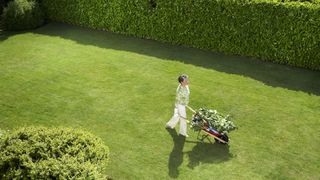The best tools in your shed for helping you to have a green lawn are a scarifier and a hollow-tine aerator, which will help you to create the conditions where grass will thrive. Of course, you’ll also want to invest in either the best gas lawn mower (opens in new tab) or the best electric lawn mower (opens in new tab) to help keep your grass looking neat and tidy. Create a suitable environment for these super-plants to grow and they’ll reward you with a winning, green and healthy performance.
Green lawn care tips
- Scarify your grass David Hedges Gower has more than 40 years of lawn care experience, recently writing the book ‘Modern Lawn Care’. The first treatment he recommends for a green lawn is scarifying, which slices through the stolons of the grass, promoting thick, lush growth. It also helps to aerate the soil, allowing it to drain more efficiently, and for nutrients and rainwater to reach the roots more easily. “Think of grass as just like any other plant in the garden. With most plants we feed, we nurture, we prune them… and we’re not constantly walking over them.” So, scarifying is a bit like pruning a plant, and you’ll need the right tools to do the job well. “A spring-tine rake is the wrong tool,” says David. “A scarifying machine is what you want. It’s powerful enough to slice through the grass stolons instead of pulling them all up. A small domestic scarifier will set you back $50–$60 and it’s worth the money.”
- Mow regularly The second crucial element to having a green lawn is regular mowing, which can mean a couple of times a week in summer, when growth is at its peak. If you have a larger backyard, you might want to invest in one of the best riding lawn mowers (opens in new tab). Alternatively, the best robot lawn mowers (opens in new tab) are a great time-saver. David is keen to point out the difference between good and bad mowing. “If we cut grass correctly with a sharpened blade, it can take up food and water better, which retains its color and boosts the plant’s health.” He recommends always keeping a spare blade in the shed, so you have one on the mower and one being sharpened up, ready for action.
- Know your grass seed Most grass varieties respond brilliantly to the dual pruning actions of regular mowing and scarifying, thickening up and sending out new fresh green shoots. Some, however, are built differently. “Many modern lawn turfs are made of dwarf rye grass,” says David. Unfortunately, although this is a lovely dark green color and grows at twice the speed, each seed makes just the one plant, so when it dies, that’s it. Sadly, it often ends up in a constant cycle of reseeding.”
- Feed your lawn When it comes to feeding, David turns to nature for instruction. “Look at nature,” he says. “History teaches us that soils nurture themselves quite easily, with the help of bacteria and microorganisms. Let nature work well and that will enhance the color of most family lawns. “Lawn feeding needs to be sustainable. So when you feed it, just feed it. Don’t try to kill weeds at the same time. If your grass is healthy it will cover the weeds naturally. He also points out that lawn feed won’t work efficiently if your lawn isn’t aerated, which is where you should use a hollow tine aerator. Again, it’s about thinking of your lawn as a collection of plants rather than a hardwearing green carpet.
- But most of all… relax “The way I think of a healthy lawns is one that can withstand what our environment throws at it and not rely too heavily on chemicals.” Summer is a time when many lawns struggle to stay green, but David says the best way to tackle this is to change your attitude to your lawn, and be patient. “Grass is a super-plant, it adapts,” he says. He also advises that it will spring up again when the rains come, so put away the sprinklers. “Losing a bit of color over the summer isn’t the end of the world. Water is the most valuable resource we have.” Discover more guides for the garden… Best chainsaws (opens in new tab) Best pool heaters (opens in new tab) Best swim spas (opens in new tab) Best water heaters (opens in new tab) Best patio heaters (opens in new tab)









